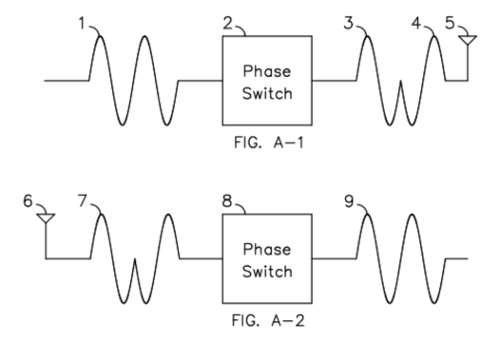The demand for more bandwidth is ever growing. The infusion of hand held smart phones and on-demand music and video has increased dramatically over recent years and the current radio spectrum is unable to keep up with demand. Sequential null wave communication technology creates a new radio spectrum that allows high information rates within extreme narrow bandwidth. Sequential null waves do not interfere with current radio communication nor does current radio communication interfere with sequential null waves.
|
Features
|
Applications
|
The new spectrum is achieved by eliminating sideband energy and through the use of sequential null cycles. The combination of these methods produces a sequential null wave that is invisible to current radio communication. A null cycle wave is a pair of phase alternated cycles that cancel each other when applied to a resonant circuit. Only recipients who know both the frequency and phase of a sequential null cycle wave can detect the energy. The number of different frequencies and phase switching algorithms can create a nearly unlimited number of communication channels.
Brief Description of Sideband Elimination
Sideband energy is eliminated by maintaining each cycle as a mathematical sine wave function. Fig. 1-2 illustrates an amplitude modulated wave without sideband elimination. FIG. 1-3 illustrates the same amplitude modulated wave with changes in amplitude set at the start or before the next cycle and the parameters are held throughout the entire sine wave cycle.

The difference between FIG. 1-2 and FIG. 1-3 is illustrated with points 12 and 16 in FIG. 1-2 and with points 20 and 23 in FIG 1-3. In FIG. 1-2, cycle 10 is shortened when followed by a higher amplitude cycle 13. Also, cycle 14 is lengthened when followed by a lower amplitude cycle 17. Each cycle in FIG. 1-3 has equal width and each cycle is at the same fundamental frequency. This same method for reducing of sideband energy can also be applied to frequency modulation.
Brief Description of Null Cycles
A sequential null wave is formed by modulating null cycles. A null cycle is a cycle that is followed by another out-of-phase cycle that cancels the first cycle. This also applies to groups of cycles that cancel each other. An example of a null wave cycle is a sine wave cycle followed by an 180 degree out-of-phase sine wave cycle as illustrated in FIG 5-2.

FIG. 5-1 illustrates a reference carrier wave. The cycles 49 and 50 in FIG. 5-1 are detectable using resonate circuits. The cycle 51 in FIG. 5-2, however, will cancel cycle 52 in a resonate circuit. The cycles illustrated in FIG. 5-3 are translated 180 degrees and will also produce sequential null cycles. A group of cycles may also be canceled by sending an out-of-phase group of cycles.
The number of different pattern shifts to produce null cycle waves is nearly infinite and only when the pattern is known can the transmission be detected. The out-of-phase cycles are reconstructed at the recipient by changing phase at the known pattern and only then can the carrier wave be detected. FIG. A-1 illustrates how a carrier wave is transmitted using null cycles.

The carrier wave 1 in FIG A-1 is converted by the phase switch 2. The resultant cycles 3 and 4 are out-of-phase with each other and the energy will cancel in a resonant circuit. The null cycles are then transmitted through the antenna 5. The output of FIG. A-1 may then be received by the antenna 6 of FIG. A-2. The received cycles are then converted by phase switch 8 into in-phase cycles 9.
Sample Sequential Null Wave
Combining the methods of sideband elimination and null cycle waves, it is possible to produce a basic amplitude modulated wave, known as a sequential null wave. The same method may be used for frequency modulation.

FIG. 7-1 illustrates a sample carrier wave. FIG. 7-2 illustrates a modulation signal. The modulation signal of FIG. 7-2 is applied to the carrier of FIG. 7-1 to produce a modulated sequential null wave illustrated by FIG. 7-3.
Download PDF of Patent
Please contact
Info@qSpectrum.com
for information regarding this technology